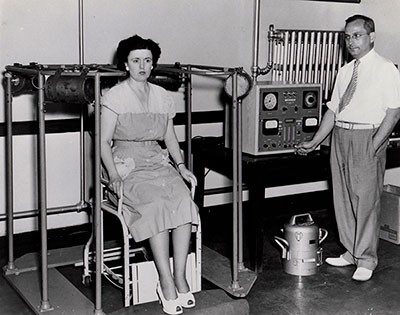FOR IMMEDIATE RELEASE | October 07, 2021
Advances that led to nuclear medicine earn Historic Chemical Landmark designation
WASHINGTON, Oct. 7, 2021 — The development of the medical use of radioiodine (RAI) — a seminal scientific discovery of the 20th century — is being honored with the American Chemical Society’s (ACS’) National Historic Chemical Landmark designation. The dedication ceremony for the Landmark will be held on Oct. 8. The event will take place at Massachusetts General Hospital (MGH) in Boston, where this lifesaving advance by Saul Hertz, M.D., had its genesis more than 80 years ago and helped lay the foundation for the field of nuclear medicine.
The story begins in the 1930s with Hertz (1905-1950), who was chief of MGH’s Thyroid Clinic. At the time, scientists had recently begun producing new radioactive isotopes. In 1936, Hertz realized it might be possible to make iodine radioactive and to use it as a radiopharmaceutical. He surmised that it could be administered to patients as a source of internal radiation to diagnose and treat diseases of the thyroid, which accumulates iodine.
Soon thereafter, Hertz and Arthur Roberts, Ph.D., a physicist at the Massachusetts Institute of Technology (MIT), began preclinical studies with RAI. On March 31, 1941, they administered the first human treatment, using RAI produced at MIT to treat an MGH patient with hyperthyroidism (overactive thyroid). Hertz and others later used RAI to diagnose and treat cancer.
“These advances — and discoveries by other researchers — laid the foundation for the modern field of nuclear medicine,” says ACS President H. N. Cheng, Ph.D. Radioiodine and other radiopharmaceuticals are now routinely used in diagnostic imaging and treatment of disease, saving and improving the lives of millions of people.”
“In the decades since this landmark work, the techniques and tools used in RAI therapy have been refined and enhanced, but the foundation of this critical therapy has persevered, restoring health and preserving quality of life for those with thyroid disease, including thyroid cancer,” says Gilbert Daniels, M.D., co-director of MGH Thyroid Associates.
“Dr. Hertz was a pioneer in the field of therapeutic nuclear medicine and was the first to administer therapeutic doses of radioactive iodine to treat thyroid disease,” says Andrew Scholte, Ph.D., who was chair of the Northeastern Section of the ACS when it sponsored the nomination for the Landmark. Today, radioactive iodine remains the preferred diagnostic tool and treatment for hyperthyroidism. This discovery represents an historical moment in the history of medical science, as well as chemistry.”
“My father’s discovery of the medical uses of RAI leaves a dynamic legacy,” says Barbara Hertz, curator of the Dr. Saul Hertz Archives. “New therapies and imaging agents continue to build on his seminal work. In addition to diagnosing and treating thyroid tumors, radiopharmaceuticals are now being used to target many other types of cancers, including neuroendocrine tumors, prostate cancer, metastatic bone cancer, neuroblastoma, as well as in the palliative treatment of liver cancer.”
This is the second National Historic Chemical Landmark in Massachusetts. The state’s other Landmark celebrates the development of Polaroid instant photography. “In both cases,” says ACS’ Cheng, “these noteworthy achievements show that chemistry truly is part of our everyday lives.”
ACS established the National Historic Chemical Landmarks program in 1992 to recognize seminal events in the history of chemistry and to increase awareness of the contributions of chemistry to society. Past Landmarks include the discovery and production of penicillin, the invention of synthetic plastics and the works of such notable scientific figures as educator George Washington Carver and environmentalist Rachel Carson. For more information, visit www.acs.org/landmarks.
To automatically receive press releases from the American Chemical Society, contact newsroom@acs.org.
Note: ACS does not conduct research, but publishes and publicizes peer-reviewed scientific studies.
Media Contact
ACS Newsroom
newsroom@acs.org


